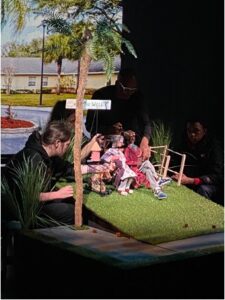
By Ira Wilder
Calyxte Campe began his artistic career as a painter, learning what he called “the old techniques” in the Charles H. Cecil Studios in Florence, Italy. He had been painting at the studio for three or four years when his instructor learned of his famous ancestor, a sculptor rather than a painter.
“He said, ‘Well, if you don’t want to sculpt, then leave my studio now,” Calyxte said.
Now, Campe is following in the footsteps of his great-great aunt, Camille Claudel.
He started sculpting under the Studio’s roof immediately after his instructor’s ultimatum, though the school had no sculpture department.
The first time he touched wet clay, he was hooked immediately, drawn to the freedom that the material’s malleability offered. He soon opened the Studio’s sculpture department and for several years taught the art form that his ancestor was known for.
Though he never met Claudel, her work surrounded him his entire life. As a young boy, Calyxte’s hands danced across the patina of her original sculptures, pieces now guarded by museum security guards around the world. Her artistic presence influenced him in ways he still doesn’t understand. Though he inherited her natural talent, he is not chasing her legacy nor is he trying to outdo her.
“If I had her name, that would be really a lot to carry,” Calyxte said. “But not having that, I think, is quite a blessing.”
Nearly a hundred years ago, Claudel sculpted her works in a studio near the Campe family’s reclusive chateau, nestled in the hills of France. Two of her works remained in the chateau until 2020, sheltered by direct lineage and untouched by the international art market.
Now, the two sculptures wait in the Turner Carroll Gallery in Santa Fe, New Mexico, for their debut at the Art Institute of Chicago in October 2023 and the Getty Museum in February 2024. The sculptures’ upcoming sale is just one chapter of the Campe family’s illustrious heritage, one molded by the hands of its artist ancestor.
Claudel destroyed most of her work, but now, her great-nephews, Calyxte and his brother Sylvester, are picking up the pieces, helping to rebuild her legacy while forging their own creative journeys.
Claudel was the pupil-turned-lover of legendary sculptor Auguste Rodin, a name that has overshadowed her legacy.
Claudel’s story was once a quiet French legend, but through media representations and art exhibitions over the past 50 years, her story has become a global anthem for feminist art historians.
Upon recognizing her talent, Claudel’s family moved to Paris in 1881, eager for her to learn at the private Acade’mie Colarossi, as the renowned Acade’mie des Beaux-Arts did not accept women at the time.
Rodin and Claudel met when she was a 19-year-old student and he a 43-year-old artist. As a sculptor, Rodin’s work was more widely known, but most do not know Claudel’s hands sculpted the finer extremities on many of Rodin’s pieces — including his tour de force “The Gates of Hell.”
“In that time, you must remember, it’s the worst time for a woman to be a sculptor, an artist, and it was all so man-orientated,” Campe said.
Early in the 20th century, French artists made their names and their money from public commissions, of which Rodin had many while Claudel had none. Once, Claudel was a finalist for one of these commissions, and Rodin was on the approval committee. He voted against her because he believed her work depicted him in an embarrassing light.
Rodin was in a long-term relationship with another woman, Rose Beuret. Despite Beuret, Claudel and Rodin signed a contract that the two of them would marry. Once it became clear to Claudel that Rodin had no plans to leave Beuret, she grew angry, drank often, and shattered wine bottles on her walls.
“This was regarded as insanity. Nowadays, I would regard it as female power,” art dealer Tonya Turner Carroll said.
Claudel lived in a world of misogynistic and religious absolutism. Her anger was seen as female hysteria and treated as such. She spent her last thirty years, rarely visited, in an asylum, where she died in 1943. Her bones now rest in the asylum’s mass grave.
Calyxte’s brother Sylvester took another creative path: filmmaking.
He worked with filmmaker Murat Eyuboglu and writer William deBuys on the 2016 eco-documentary “The Colorado,” a film shown in museums across the country. Because of its success, the pair teamed up again for an upcoming documentary on the Amazon River, whose surrounding forests endure devastating wildfires almost annually.
When the project ran out of funding, though, Sylvester proposed a solution that crossed borders and brokering conventions.
He offered the team some stake in Claudel’s “L’Implorante” and “Chienne Rongeant Son Os,” the two sculptures that the Campe brothers cherished in their home as children.
To sell them, the team needed an art dealer. deBuys knew one: Tonya Turner Carroll, a friend with a mutual alma mater, UNC-Chapel Hill.
Turner Carroll and her husband opened the Turner Carroll Gallery in 1991. The Gallery primarily highlights artists from marginalized communities. Tonya, as a historian, specializes in female artists and considers herself a scholar on Claudel.
Now, the couple, with the trust of Claudel’s descendants, await their largest sale yet with the “L’Implorante.”
The “L’Implorante,” a 1905 bronze cast, is one that many consider to be Claudel’s greatest work. The Gallery expects the sculpture to go for at least $4 million if purchased before its October debut and at least $6.5 million later.
Five casts were commissioned by Claudel’s art dealer, Eugène Blot. One was bought by Claudel’s brother, Paul, and remained in the family’s homestead until 2020, when it was moved to the Turner Carroll Gallery. The other four now rest in museums and private collections across the world.
At the Campe family’s invitation, Turner Carroll and her husband, Michael, flew to France to see the sculptures for the first time. She knew it was a milestone, personally and professionally.
“I felt like I was in the presence of the most pivotal work of art history,” she said. “It was the masterwork of the greatest woman sculptor up to that time.”
When the Carrolls walked through the Campe house for the first time, Tonya almost could not tell the difference between Claudel and her great-great nephew’s work.
“It was almost like he had absorbed her artistic touch by growing up with her work and touching it, even though he never met her in person,” she said.
The Carrolls completely immersed themselves into Claudel’s story, visiting the asylum she died in, closely befriending her descendants and ensuring their actions were beneficial to her legacy.
It took the couple a year to get the sculptures out of the country legally. Now, it’s the only “L’Implorante” cast of its size in the United States; a smaller one is held at the Metropolitan Museum of Art.
Turner Carroll’s “L’Implorante” is accompanied by a bronze titled “Chienne Rongeant Son Os” (Dog Gnawing Her Bone). The “Chienne” was cast from an original Claudel mold in 2002 by Calyxte Campe himself. He is Claudel’s sole remaining descendant with sculpting experience.
The “Chienne” mold that Calyxte grew up around and worked with is one of few remaining Claudel molds that she did not destroy.
Today, less than a hundred of Claudel’s works remain. As Claudel broke away from Rodin to escape his shadow and his snare, she destroyed most of her own works out of spite.
“Camille was suffocated by societal expectations for women, but her craft was where she was free — and then that was stolen from her,” Emily Smither said. Smither has been an intern at the Gallery for several months, working closely on the distribution and advertising of Claudel’s pieces.
For aspiring art historians like Smither, Claudel’s story is an important one, reflective of blooming conversations in the art world about cultural value in relation to the artist.
“How do we reconcile with a great artist like Rodin but admit the wrongdoings? What about the thousands of other women who don’t have as much evidence of abuse?” she said.
Claudel’s story is also a crucial piece to understanding the art world as a whole.
“It’s pivotal, in terms of understanding how the art world works, how the role of women in the arts works, how the economics of the art world works,” Michael Carroll said.
Curators from the Art Institute of Chicago and the Getty Museum traveled together to Santa Fe to see the L’Implorante and decided it would be the centerpiece of an upcoming dual exhibition: “Camille Claudel: Revolt against Nature.” The exhibition’s title is a double entendré on the piece’s hopeful assistance to the Amazon and Claudel’s contemporary rebellion against the constraints of womanhood.
Calyxte said he hopes the pieces will soon have a permanent home in a public museum, where Claudel’s work can be admired for its exquisite emotion and her story can be lauded among other artists of her time.
The filmmaking team knows that their documentary is unlikely to save the Amazon, but the film and the sculptures represent a new type of exchange in the art world — a business model centered around social justice, one that Smither is hopeful will be more common in years to come.
“Sometimes art can make people think, especially to see about issues in ways they never would have otherwise. And, sometimes art can only bear witness to things that are happening out in the world. But either way, its role is vital,” deBuys said.
For Tonya Turner Carroll, working with Claudel’s pieces is not just another day on the job — it’s part of an ongoing Claudel renaissance, a celebration of an artist who defied the expectations of her gender and her time.
Edited by Will Christensen and Nathan Wellish




